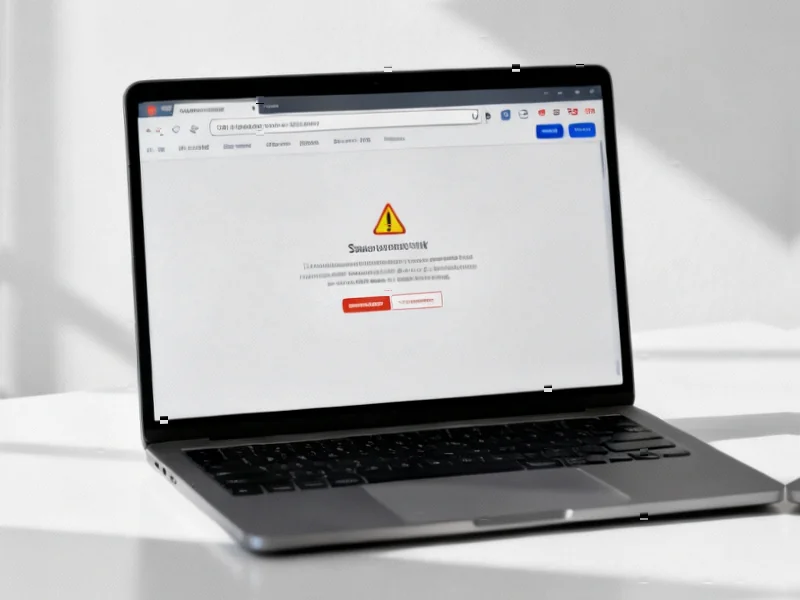According to PCWorld, security researcher Jose Pino has discovered a critical vulnerability affecting all Chromium-based browsers including Chrome, Edge, Opera, Vivaldi, Arc, and Brave. The flaw, named Brash, impacts browsers based on Chromium versions up to 143.0.7483.0 and exists in Blink, the rendering engine that powers these browsers. Pino demonstrated that the vulnerability allows attackers to collapse browsers within 15 to 60 seconds by exploiting unlimited API updates that can inject millions of DOM mutations per second, saturating the main thread and disrupting the event loop. The vulnerability affects over 3 billion users across desktop, Android, and embedded environments, with Google still investigating and no patch yet released. This widespread exposure demands immediate industry attention.
Table of Contents
Understanding the Core Vulnerability
The Brash vulnerability represents a fundamental architectural oversight in how Chromium-based browsers manage resource allocation for DOM operations. Unlike traditional buffer overflow or memory corruption issues, this flaw stems from the absence of rate limiting mechanisms for API updates. In modern web architecture, the Document Object Model serves as the programming interface for web documents, and when malicious code can manipulate millions of DOM elements per second without constraints, it creates a cascading failure throughout the browser’s execution environment. The Blink rendering engine, which handles these operations, wasn’t designed with sufficient safeguards against such volumetric attacks on its processing pipeline.
Beyond Browser Crashes: Systemic Risks
While initial demonstrations show browsers freezing harmlessly, the real danger lies in how this vulnerability could be weaponized in targeted attacks. Imagine critical systems relying on Chrome for embedded applications—medical devices, industrial control systems, or financial trading platforms. A coordinated attack could disrupt essential services by overwhelming the underlying systems. The vulnerability’s ability to “halt or slow down other processes running simultaneously” suggests potential for broader system instability, particularly on resource-constrained mobile devices running Edge or other Chromium-based browsers. This isn’t merely about browser crashes; it’s about the potential for systemic disruption across multiple sectors.
The Browser Security Landscape Shifts
This discovery highlights the inherent risks of browser monoculture, where Chromium’s dominance creates single points of failure affecting billions simultaneously. While Firefox and Safari remain unaffected, their market share limitations mean most organizations and users remain exposed. The timing couldn’t be more critical as businesses increasingly rely on web applications for core operations. We’re likely to see accelerated enterprise adoption of alternative browsers for specific high-security use cases, and increased scrutiny of Chromium’s security architecture from corporate security teams. This vulnerability may also prompt regulatory attention toward browser security standards, particularly for critical infrastructure applications.
The Race Against Exploitation
Google’s ongoing investigation without an immediate patch raises concerns about the complexity of implementing a proper fix. Rate limiting DOM operations isn’t a simple toggle—it requires careful balancing to avoid breaking legitimate web applications that might require high-frequency updates. The development team must architect a solution that distinguishes between normal operation and malicious activity, which could take weeks or months to properly test and deploy. Meanwhile, the public demonstration at brash.run provides a blueprint for potential attackers, creating a dangerous window of exposure. Organizations should prepare contingency plans, including browser diversification strategies and enhanced monitoring for unusual system resource consumption that might indicate exploitation attempts.
Future-Proofing Browser Security
This incident should serve as a wake-up call for the entire web ecosystem. Beyond immediate patching, we need fundamental reconsideration of how browsers handle resource allocation and process isolation. The industry may need to develop more sophisticated sandboxing techniques or implement machine learning-based anomaly detection to identify unusual DOM manipulation patterns. Additionally, this vulnerability underscores the importance of independent security research in an increasingly consolidated browser market. As Chromium continues to dominate, the responsibility on Google’s security team grows exponentially, and the consequences of architectural flaws become increasingly severe for the global digital infrastructure.



